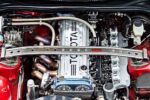The 2007 Jeep Wrangler has earned a reputation for its ruggedness and off-road capabilities, but like any vehicle, it comes with its share of engine issues. Owners of this model often report a variety of symptoms that can indicate underlying problems. Understanding these symptoms is crucial for any Jeep enthusiast or owner to ensure the longevity and performance of their vehicle.
Common Symptoms of Engine Issues
Performance Problems
When the engine starts to show signs of trouble, the first noticeable symptom is usually a decline in performance. This can manifest in several ways:
- Loss of Power: The Jeep may struggle to accelerate, especially when climbing hills or carrying heavy loads.
- Rough Idling: If the engine feels like it’s shaking or vibrating when idling, this could indicate a misfire or other internal issues.
- Unusual Noises: Listen for knocking, ticking, or grinding sounds that weren’t there before. These noises can signal serious problems.
Fuel Efficiency Issues
Another common symptom is a noticeable drop in fuel efficiency. If you find yourself stopping at the pump more often, it might be time to investigate further.
- Increased Fuel Consumption: A sudden spike in how much gas you’re using can indicate engine problems.
- Check Engine Light: This warning light can be triggered by various engine issues, including those affecting fuel efficiency.
Engine Overheating
Overheating is a serious concern for any vehicle, and the 2007 Wrangler is no exception. If you notice the temperature gauge creeping into the red zone, take it seriously.
- Steam from the Hood: If you see steam or smell coolant, your engine could be overheating.
- Coolant Leaks: Puddles of coolant under the vehicle can indicate a leak, which can lead to overheating.
Starting Issues
Difficulty starting the engine can be another red flag. If your Jeep struggles to turn over or requires multiple attempts to start, it could be a sign of battery or starter issues.
- Clicking Sounds: A clicking noise when you turn the key can indicate a weak battery or starter problem.
- Slow Crank: If the engine cranks slowly, it may indicate battery issues or problems with the starter motor.
Exhaust Issues
Pay attention to the exhaust coming from your Jeep. Unusual smells or colors can indicate engine problems.
- Blue Smoke: This can indicate oil burning in the engine, which is a sign of wear.
- Black Smoke: This could mean the engine is running too rich, often due to fuel injection issues.
Understanding these symptoms is essential for any owner of a 2007 Jeep Wrangler. Early detection of engine problems can save you time, money, and headaches down the road. If you notice any of these signs, it’s wise to consult a qualified mechanic to diagnose the issue before it escalates.
Understanding Engine Problems in the 2007 Jeep Wrangler
The 2007 Jeep Wrangler is a beloved vehicle among off-road enthusiasts, but it has its fair share of engine issues that can frustrate owners. Knowing the causes behind these problems can help you address them before they escalate. Here, we break down some common engine problems reported by Jeep owners, along with insights gathered from various forums.
Common Causes of Engine Problems
Understanding the root causes of engine problems can help you take proactive measures. Below are some of the most frequently cited issues:
| Engine Problem | Possible Causes | Symptoms |
|---|---|---|
| Loss of Power |
|
|
| Rough Idling |
|
|
| Overheating |
|
|
| Starting Issues |
|
|
| Exhaust Problems |
|
|
Owner Opinions and Experiences
Many Jeep Wrangler owners have shared their experiences regarding engine problems on various forums. Here are some common sentiments:
– “I’ve had my 2007 Wrangler for a few years, and the loss of power is frustrating. It feels like it can’t keep up, especially on steep inclines. I’ve replaced the fuel filter, but it still struggles.”
– “The rough idling is annoying. Sometimes it feels like the engine is going to stall when I stop at a light. I think it’s a vacuum leak, but I haven’t found it yet.”
– “Overheating is a real concern. I had to replace the thermostat last summer, but I still worry about it when I’m off-roading. I always keep an eye on the temperature gauge now.”
– “Starting issues have been a headache. I replaced the battery, but it still clicks when I turn the key. I suspect it might be the starter motor.”
– “I’ve noticed blue smoke coming from the exhaust, which has me worried. I think it might be burning oil, and I don’t want to face a major engine rebuild.”
These opinions highlight the various challenges faced by 2007 Jeep Wrangler owners. Recognizing these issues early can help in addressing them effectively. If you experience any of these symptoms, it’s advisable to consult a qualified mechanic who can provide a thorough diagnosis and recommend appropriate repairs.
Recalls and Technical Service Bulletins for Engine Problems
When it comes to the 2007 Jeep Wrangler, there have been several recalls and Technical Service Bulletins (TSBs) issued that address engine-related issues. Understanding these recalls and TSBs can provide valuable insight into common problems and potential fixes for owners experiencing engine troubles.
Recalls
Recalls are issued when a manufacturer identifies a safety-related defect or non-compliance with federal safety standards. For the 2007 Jeep Wrangler, the following recalls have been noted:
- Recall for Fuel Pump: In 2010, a recall was issued due to a potential issue with the fuel pump that could cause the engine to stall. This was particularly concerning for owners who rely on their vehicles for off-road adventures.
- Recall for Ignition Switch: A recall was also issued for problems related to the ignition switch, which could lead to difficulty starting the engine or even cause the engine to shut off while driving.
These recalls highlight specific areas where the manufacturer recognized potential problems that could affect engine performance and safety.
Technical Service Bulletins (TSBs)
TSBs are issued by manufacturers to inform dealers and technicians about known issues and recommended repairs. For the 2007 Jeep Wrangler, several TSBs have been released that address engine problems:
| TSB Number | Issue Addressed | Summary |
|---|---|---|
| 18-005-08 | Rough Idle | This bulletin provides guidance on diagnosing and repairing rough idle conditions, often caused by vacuum leaks or faulty sensors. |
| 18-021-09 | Engine Stalling | This TSB outlines steps for diagnosing engine stalling issues, which may include checking the fuel delivery system and electrical components. |
| 18-022-10 | Overheating | This bulletin discusses overheating issues, recommending checks for coolant levels, thermostat functionality, and radiator condition. |
Importance of TSBs
TSBs serve as a crucial resource for mechanics and owners alike. They provide detailed information about common issues and the manufacturer’s recommended fixes. By following these guidelines, mechanics can more effectively diagnose and repair engine problems, potentially saving owners time and money.
Conclusion
While recalls address safety-related defects, TSBs provide a broader scope of information on known issues, helping to ensure that 2007 Jeep Wrangler owners are informed and can take appropriate action. If you’re experiencing engine problems, it’s wise to check for any relevant recalls or TSBs that may apply to your vehicle.
Or open the survey in a new tab: Take the Survey




0 Comments